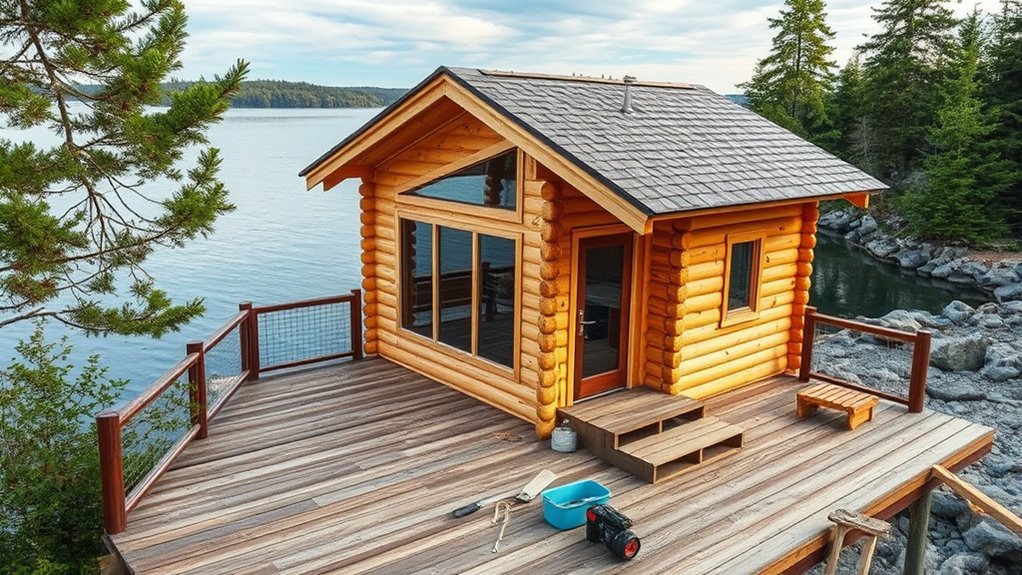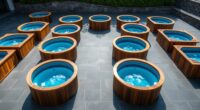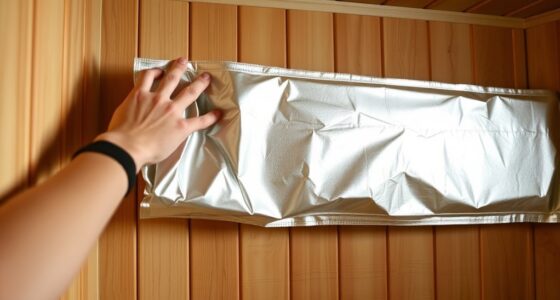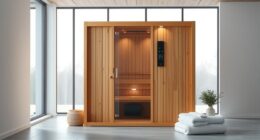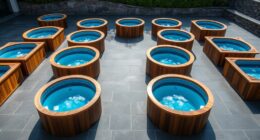When building a lakeside sauna, choose sustainable materials like responsibly sourced cedar or reclaimed wood to minimize environmental impact. Use eco-friendly insulation and finishes with low-VOC or natural ingredients to protect water quality and wildlife. Plan construction carefully to reduce habitat disturbance, and select environmentally friendly coatings to extend lifespan without harm. By considering these factors, you’ll create a beautiful, eco-conscious retreat that preserves the natural beauty of your waterfront. Keep exploring to discover more eco-smart building tips.
Key Takeaways
- Use sustainably sourced, moisture-resistant woods like cedar or spruce to ensure durability and eco-friendliness.
- Select natural, low-VOC insulation and finishes to protect water quality and reduce environmental impact.
- Plan construction to minimize habitat disruption and prevent habitat destruction during installation.
- Choose eco-friendly exterior finishes and sealants that protect the sauna without leaching harmful chemicals into the lake.
- Design the sauna to blend seamlessly with the natural landscape, ensuring long-term sustainability and minimal ecological footprint.
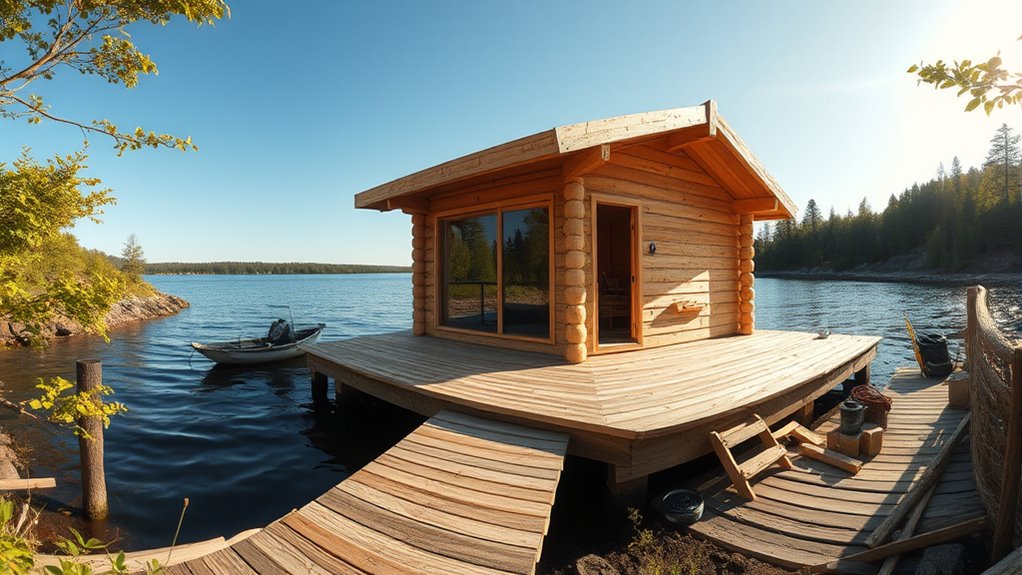
Building a lakeside sauna offers a perfect way to enjoy nature while relaxing in comfort. When you’re planning your waterfront retreat, one of the most important considerations is selecting the right sauna materials. The materials you choose not only influence the sauna’s durability and aesthetic appeal but also impact the environment. Opting for sustainable and eco-friendly options helps minimize your environmental impact and ensures your sauna remains a harmonious part of the natural landscape.
Start by considering the types of wood used in your sauna. Traditional choices like cedar, spruce, or hemlock are popular because they’re naturally resistant to moisture and decay, making them ideal for lakeside environments. However, the source of your wood matters. Look for suppliers that prioritize sustainably harvested timber or reclaimed wood to reduce your carbon footprint. Using environmentally responsible sauna materials allows you to enjoy your retreat without contributing to deforestation or habitat destruction.
Choose sustainably sourced cedar, spruce, or hemlock to ensure eco-friendly lakeside sauna construction.
In addition to wood, pay attention to other materials used in construction and insulation. Many conventional options include synthetic or non-renewable materials that can have a higher environmental impact. Instead, explore natural insulation options like sheep’s wool or cork, which are biodegradable and offer excellent thermal performance. These choices not only help insulate your sauna efficiently but also reduce the overall environmental footprint of your project.
When it comes to the sauna’s exterior, consider using environmentally friendly finishes and sealants. Many traditional products contain volatile organic compounds (VOCs) that can leach into the surrounding water and soil, harming aquatic life. Look for low-VOC or natural alternatives that provide protection against moisture while being safe for the lakeside environment.
Another key factor is the installation process itself. Choose contractors who are mindful of their environmental impact, such as those who minimize waste and use eco-conscious construction techniques. Proper planning can also prevent unnecessary disruption to the natural setting, preserving the beauty of your waterfront property.
Additionally, incorporating attention to environmental impact during the design process can help you make more sustainable choices and reduce long-term ecological effects. Ultimately, your goal should be to create a sauna that blends seamlessly with its environment while respecting natural resources. By carefully selecting sauna materials and considering their environmental impact, you can build a sustainable, beautiful retreat that enhances your lakeside experience. This mindful approach not only benefits the planet but also ensures that future generations will be able to enjoy the serenity and beauty of your waterfront property as much as you do now.
Frequently Asked Questions
What Are the Best Materials for Lakeside Sauna Construction?
You should choose durable, water-resistant wood like cedar or redwood for your lakeside sauna construction. These woods resist moisture and decay, making them ideal for waterfront settings. For sauna insulation, opt for mineral wool or foam boards that handle high temperatures and moisture well. This combination guarantees your sauna stays well-insulated, safe, and long-lasting, even in the humid lakeside environment.
How Do I Ensure Privacy From Neighboring Properties?
You can guarantee privacy from neighbors by strategically placing privacy fencing and using landscape screening like tall trees or shrubs. Coincidentally, these natural barriers not only block sightlines but also blend seamlessly with your lakeside setting. Plant fast-growing evergreens or install a wooden fence to create a cozy, secluded sauna experience. Regular maintenance keeps these barriers effective, so you enjoy your lakeside retreat without unwanted gazes.
Are There Specific Building Codes for Waterfront Saunas?
Yes, there are specific building codes for waterfront saunas. You need to follow waterfront setbacks, which dictate how close you can construct to the shoreline, and adhere to dock regulations if your sauna is near a dock. Check local zoning laws to guarantee compliance, and obtain necessary permits beforehand. These regulations help protect the environment, ensure safety, and maintain harmony with neighboring properties.
How Can I Minimize Environmental Impact During Construction?
You can minimize environmental impact by choosing eco-friendly insulation like recycled or natural materials, reducing energy waste. Be mindful during construction to avoid disturbing native wildlife and vegetation. Incorporate native plant landscaping around your sauna to prevent erosion and support local ecosystems. Use sustainable building practices, limit excavation, and prevent runoff into the lake. These steps help preserve the natural beauty and health of your waterfront environment while building your lakeside sauna.
What Maintenance Is Required for Lakeside Saunas?
Maintain your lakeside sauna by regularly cleaning surfaces to prevent buildup and guarantee hygiene. Schedule consistent heater maintenance to keep it functioning efficiently and safely. Check seals, vents, and stones periodically, and clean the interior and exterior to prevent mold and dirt. Proper upkeep prolongs your sauna’s lifespan, preserves its performance, and enhances your relaxation. You’ll enjoy a clean, cozy retreat whenever you need it, all while protecting your waterfront environment.
Conclusion
Building a lakeside sauna enhances your waterfront property, offering relaxation and scenic views. Just remember, approximately 60% of lakeside homeowners report increased property value after adding a sauna, making it a smart investment. By carefully considering location, permits, and environmental impact, you create a peaceful retreat that complements your natural surroundings. So, take your time planning, and enjoy the numerous benefits of your new lakeside sanctuary for years to come.
